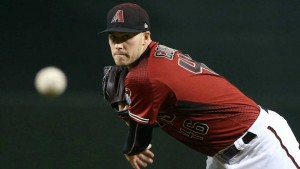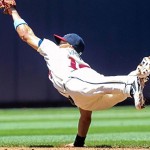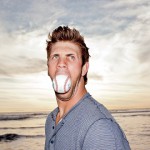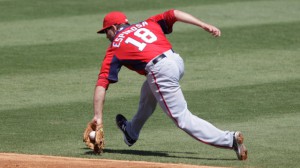Was walking into dinner last night and happened to glance at RSS sports feed … and saw this shocker: Patrick Corbin signs with the Nats. 6yrs/$140M.
And my first reaction was this: wow, the Nats just beat out the frigging New York Yankees for a player. In the FA market, straight up. Wow. Reports from earlier in the day had indicated Corbin was down to just the Yanks and the Nats and I figured, “well, he’s on record saying he has dreamed about playing in New York, oh well.” Then a few hours later he’s wearing a Washington hat.
I have a few immediate thoughts on this. Negative and positive.
- Its not my money, but $23M/year AAV does seem like a lot for a guy who posted a 5.15 ERA just two years ago.
- Its also a ton of money to commit to a player who really has only performed like a real Ace worthy of this level of financial commitment for one year.
- That being said, he’s in-arguably the best pitcher on the FA market and the Nats got him. Before the winter meetings even.
- He’s a lefty too, nicely replacing the near replacement-level we got out of Gio Gonzalez this past year.
- I daresay he might now be the best 3rd starter in the majors. Houston’s rotation is half out the door in FA, Cleveland’s rotation is in the process of getting dismantled this off-season.
- Its worth mentioning that Corbin has been pitching in one of the better hitter’s park in the majors … and probably will benefit and get a bump in numbers by moving to the NL East and moving to a more neutral park in Nationals park.
- We get his age 29-34 seasons. That’s not too bad honestly, given what we know about player decline. He’s got less than 1,000 MLB innings on his arm, which is not a ton by age 28. By way of comparison, Max Scherzer had 1,017 MLB innings through his own age 28 season.
- Corbin is also the kind of guy who seems like he’d age gracefully, in a similar fashion to a guy like Tom Glavine. He doesn’t depend on a ton of velocity (vFA in 2018 of 91.3). Something obviously clicked with him in 2018 because his K rate skyrocketed, his walk rate fell, the value of his slider exploded, and he seemed to add a curve to his repertoire. He’s already had his Tommy John, so that’s nice that he’s gotten that out of the way.
- Is this yet another Rizzo-to-Arizona connection? Maybe not: he was drafted in 2009 by the Angels, traded to Arizona in 2010 by which time Rizzo was in Washington. Hopefully we’re now completely out of that cynical view of player acquisition from Rizzo’s background.
Speaking of, Mike Rizzo is being incredibly aggressive this off-season. For all the concerns we may have had about Bryce Harper‘s signing possibly gumming up the works … this team is moving. We had three-to-four major issues this off-season:
- Catcher; he’s signed two guys, including the 2018 AL All-star
- Starters: he’s signed the best available hurler.
- 2B: nothing yet … but this was always going to be the easiest position to fill in FA thanks to a glut of available players
- Relievers: he’s traded for a solid middle-relief RHP and has signed a high-upside former dominant closer to a reasonable contract.
Other information about this transaction that may have other implications:
- Nats roster now at 38/40. Still room on the broom.
- Payroll implications: before this move I had the team with $43.8M available under the luxury cap. This moves cuts them to about $20.5M under the cap. I’ve read stuff in the press saying the team wants to stay a bit under the cap to allow for mid-season upgrades … so maybe we’ll see another $10-$15M in spending. That should be enough to buy what they still need:
- 5th starter reclamation projects
- starting 2B (Marwin Gonzalez, Lowrie, LeMahieu, Dozier, Kinsler, Phillips, Walker … Daniel Murphy?). Lots of options, not all of which will cost a lot
- lefty bench bat (Justin Bour? just got non-tendered, is from the area, would fit in perfectly)
- This move will shred the 2019 draft for this team, costing them their second- and fifth-highest picks (as well as $1 million in international bonus pool money). Poor cap management comes back to bite them. Definitely an “all-in move” throwing draft caution to the wind. They better really hit on that 4th round comp pick 🙂 (update: well technically if Harper leaves, then that 4th round comp pick would be the 5th highest pick … so it’d instantly disappear like it never got awarded. Just to clarify).
- Rotation now projected to be Scherzer, Strasburg, Corbin, Ross and Roark. All 5 with guaranteed deals, four of them with 8-figure deals likely for 2019. No room for Erick Fedde here, despite his Winterfest statements. That’s got to be a tough nut to swallow for him, even given the fact that he hasn’t really earned it. But, as we all know teams end up giving starts to 8-9 guys generally, and he’s first in line right now, so he still has hope. But our SP depth is ugly: Fedde, Voth, McGowin, fresh-from-the-Mexican-league Henderson Alvarez, and then whatever MLFA reclamation project we can find in the Jeremy Hellickson ilk. I do think this signing makes it a lot tougher for the Nats to find this role since they really can’t promise that player a non-injury shot at a 5th starter 25-man role. So we’ll be looking at players who will be willing from the go to accept an AAA assignment … and one in Fresno to boot.
Any other thoughts? Is this the move that pushes the team back to the top of the NL East and really makes them a contender in 2019?
My official take: the Nats bought the best arm they could. This is better than the alternatives they faced this off-season. It only cost them money, not more prospects, and in that respect its a complete win. They’re using the payroll that they earned by virtue of 2018 expiring contracts well.
Does this move preclude them now from signing Harper? Well, unless the team plans on trading away Scherzer … it should. Or if the Lerners decide to go Boston-style and really blow out payroll and say “F it completely,” then they still can (and always could). But if i’m Scott Boras i’m kinda shaking in my boots today, knowing that the likelihood of Harper’s baseline pillow 10yr/$300M deal from this team is likely gone.



